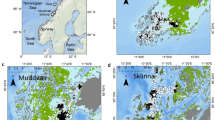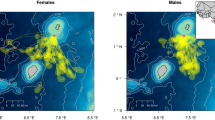Abstract
Top predators are critical to ecosystem function, exerting a stabilising effect on the food web. Brown skuas are opportunistic predators and scavengers. Although skuas are often the dominant land-based predator at seabird colonies, this is the first detailed study of their movements and activity during breeding. The study was carried out at Bird Island, South Georgia (54°00′S, 38°03′W), in the austral summer of 2011/2012 and included GPS data from 33 breeding adults tracked during the late incubation and early chick-rearing periods. Brown skuas spent on average more than 80 % of time in the territory, and it was extremely rare for both partners to leave the territory simultaneously. Much more time was spent foraging at the coast than in penguin colonies and, based on saltwater immersion data, adults never foraged at sea. None of the tracked birds appeared to specialise in catching small petrels at night. Fewer foraging trips were made per day, and hence, more time was spent in the territory, during incubation than chick-rearing. Despite the pronounced sexual size dimorphism, there were no effects of sex on territorial attendance, foraging time or habitat use. Skuas at Bird Island show higher territorial attendance and are less likely to leave the territory unattended than those breeding elsewhere, suggesting closer proximity to more diverse or abundant food resources than at other colonies. The results tie in with previous diet studies, indicating that brown skuas at this site feed mostly on seal placentae and carrion and that birds may rely on a broader range of food resources as the season progresses.


Similar content being viewed by others
References
Ainley DG, Hyrenbach KD (2010) Top-down and bottom-up factors affecting seabird population trends in the California current system (1985–2006). Prog Ocean 84:242–254. doi:10.1016/j.pocean.2009.10.001
Anderson ORJ, Phillips RA, Shore RF et al (2009) Diet, individual specialisation and breeding of brown skuas (Catharacta antarctica lonnbergi): an investigation using stable isotopes. Polar Biol 32:27–33. doi:10.1007/s00300-008-0498-9
Annett C, Pierotti R (1989) Chick hatching as a trigger for dietary switching in the western gull. Colon Waterbirds 12:4–11. doi:10.2307/1521306
Barron DG, Brawn JD, Weatherhead PJ (2010) Meta-analysis of transmitter effects on avian behaviour and ecology. Methods Ecol Evol 1:180–187. doi:10.1111/j.2041-210X.2010.00013.x
Bates D, Maechler M, Bolker B (2013) lme4: linear mixed-effects models using S4 classes. R package version 0.999999-2
Brooke MdeL, Keith D, Røv N (1999) Exploitation of inland-breeding Antarctic petrels by south polar skuas. Oecologia 121:25–31. doi:10.1007/s004420050903
Burton RW (1968) Breeding biology of the brown skua, Catharacta skua lonnbergi (Mathews), at Signy Island, South Orkney Island. Br Antarct Surv Bull 15:9–28
Caldow R, Furness R (2000) The effect of food availability on the foraging behaviour of breeding great skuas Catharacta skua and Arctic skuas Stercorarius parasiticus. J Avian Biol 31:367–375. doi:10.1034/j.1600-048X.2000.310313.x
Calenge C (2012) The package ‘adehabitatLT’ for the R Software: analysis of animal movements
Catry P, Furness R (1999) The influence of adult age on territorial attendance by breeding great skuas Catharacta skua: an experimental study. J Avian Biol 30:399–406. doi:10.2307/3677012
Catry P, Ratcliffe N, Furness RW (1998) The influence of hatching date on different life-history stages of great skuas Catharacta skua. J Avian Biol 29:299–304. doi:10.2307/3677112
Catry P, Phillips RA, Furness RW (1999) Evolution of reversed sexual size dimorphism in skuas and jaegers. Auk 116:158–168
Fridolfsson AK, Ellegren H (1999) A simple and universal method for molecular sexing of non-ratite birds. J Avian Biol 30:116–121
Furness RW (1987) The skuas. T and AD Poyser, Calton
Furness RW, Camphuysen CJ (1997) Seabirds as monitors of the marine environment. ICES J Mar Sci 54:726–737. doi:10.1006/jmsc.1997.0243
González-Solís J, Croxall JP, Wood AG (2000) Sexual dimorphism and sexual segregation in foraging strategies of northern giant petrels, Macronectes halli, during incubation. Oikos 90:390–398. doi:10.2307/3547150
Grémillet D, Dell’Omo G, Ryan PG et al (2004) Offshore diplomacy, or how seabirds mitigate intra-specific competition: a case study based on GPS tracking of Cape gannets from neighbouring colonies. Mar Ecol-Prog Ser 268:265–279. doi:10.3354/meps268265
Grilli MG, Montalti D (2012) Trophic interactions between brown and south polar skuas at Deception Island, Antarctica. Polar Biol 35:299–304. doi:10.1007/s00300-011-1054-6
Hahn S, Bauer S (2008) Dominance in feeding territories relates to foraging success and offspring growth in brown skuas Catharacta antarctica lonnbergi. Behav Ecol Sociobiol 62:1149–1157. doi:10.1007/s00265-007-0543-7
Hahn S, Peter H (2003) Feeding territoriality and the reproductive consequences in brown skuas Catharacta antarctica lonnbergi. Polar Biol 26:552–559. doi:10.1007/s00300-003-0522-z
Hahn S, Reinhardt K, Ritz MS et al (2007) Oceanographic and climatic factors differentially affect reproduction performance of Antarctic skuas. Mar Ecol-Prog Ser 334:287–297. doi:10.3354/meps334287
Hamer KC, Furness RW, Caldow RWG (1991) The effects of changes in food availability on the breeding ecology of great skuas Catharacta skua in Shetland. J Zool 223:175–188. doi:10.1111/j.1469-7998.1991.tb04758.x
Heithaus MR, Frid A, Wirsing AJ, Worm B (2008) Predicting ecological consequences of marine top predator declines. Trends Ecol Evol 23:202–210. doi:10.1016/j.tree.2008.01.003
Hemmings AD (1984) Aspects of the breeding biology of McCormick’s skua Catharacta maccormicki at Signy Island, South Orkney Islands. Br Antarct Surv Bull 65:65–79
Hipfner JM, McFarlane-Tranquilla L, Addison B, Hobson KA (2013) Trophic responses to the hatching of offspring in a central-place foraging seabird. J Ornithol (n.d.):1–6. doi:10.1007/s10336-013-0962-3
Hunter I, Croxall JP, Prince PA (1982) The distribution and abundance of burrowing seabirds (Procellariiformes) at Bird Island, South Georgia: I. Introduction and methods. Br Antarct Surv Bull 56:49–57
Jenouvrier S, Weimerskirch H, Barbraud C et al (2005) Evidence of a shift in the cyclicity of Antarctic seabird dynamics linked to climate. Proc Biol Sci 272:887–895. doi:10.1098/rspb.2004.2978
Käkelä A, Crane J, Votier SC et al (2006) Fatty acid signatures as indicators of diet in great skuas Stercorarius skua, Shetland. Mar Ecol-Prog Ser 319:297–310. doi:10.3354/meps319297
Maher WJ (1974) Ecology of pomarine, parasitic and long-tailed jaegers in Northern Alaska. Pac Coast Avifauna 37:1–148
Moncorps S, Chapuis J, Haubreux D, Bretagnolle V (1998) Diet of the brown skua Catharacta skua lonnbergi on the Kerguelen archipelago: comparisons between techniques and between islands. Polar Biol 19:9–16
Mougeot F, Genevois F, Bretagnolle V (1998) Predation on burrowing petrels by the brown skua (Catharacta skua lonnbergi) at Mayes Island, Kerguelen. J Zool 244:429–438. doi:10.1111/j.1469-7998.1998.tb00047.x
Navarro J, Louzao M, Igual JM et al (2009) Seasonal changes in the diet of a critically endangered seabird and the importance of trawling discards. Mar Biol 156:2571–2578. doi:10.1007/s00227-009-1281-3
Österblom H, Casini M, Olsson O, Bignert A (2006) Fish, seabirds and trophic cascades in the Baltic Sea. Mar Ecol-Prog Ser 323:233–238. doi:10.3354/meps323233
Oswald SA, Bearhop S, Furness RW et al (2008) Heat stress in a high-latitude seabird: effects of temperature and food supply on bathing and nest attendance of great skuas Catharacta skua. J Avian Biol 39:163–169. doi:10.1111/j.2008.0908-8857.04187.x
Paine RT (1966) Food web complexity and species diversity. Am Nat 100:65–75. doi:10.2307/2459379
Péron C, Authier M, Barbraud C et al (2010) Interdecadal changes in at-sea distribution and abundance of subantarctic seabirds along a latitudinal gradient in the southern Indian Ocean. Glob Change Biol 16:1895–1909. doi:10.1111/j.1365-2486.2010.02169.x
Phalan B, Phillips RA, Silk JRD et al (2007) Foraging behaviour of four albatross species by night and day. Mar Ecol-Prog Ser 340:271–286. doi:10.3354/meps340271
Phillips RA, Caldow RWG, Furness RW (1996) The influence of food availability on the breeding effort and reproductive success of Arctic skuas Stercorarius parasiticus. Ibis 138:410–419. doi:10.1111/j.1474-919X.1996.tb08059.x
Phillips RA, Thompson DR, Hamer KC (1999) The impact of great skua predation on seabird populations at St Kilda: a bioenergetics model. J Appl Ecol 36:218–232. doi:10.1046/j.1365-2664.1999.00391.x
Phillips RA, Dawson D, Ross D (2002) Mating patterns and reversed size dimorphism in southern skuas (Stercorarius skua lonnbergi). Auk 119:858–863. doi:10.1642/0004-8038(2002)119[0858:MPARSD]2.0.CO;2
Phillips RA, Xavier JC, Croxall JP, Burger AE (2003) Effects of satellite transmitters on albatrosses and petrels. Auk 120:1082–1090. doi:10.1642/0004-8038(2003)120[1082:EOSTOA]2.0.CO;2
Phillips RA, Phalan B, Forster I (2004a) Diet and long-term changes in population size and productivity of brown skuas Catharacta antarctica lonnbergi at Bird Island, South Georgia. Polar Biol 27:555–561. doi:10.1007/s00300-004-0633-1
Phillips RA, Silk JRD, Phalan B et al (2004b) Seasonal sexual segregation in two Thalassarche albatross species: competitive exclusion, reproductive role specialization or trophic niche divergence? Proc R Soc Ser B 271:1283–1291. doi:10.1098/rspb.2004.2718
Phillips RA, Catry P, Silk JRD et al (2007) Movements, winter distribution and activity patterns of Falkland and brown skuas: insights from loggers and isotopes. Mar Ecol-Prog Ser 345:281–291. doi:10.3354/meps06991
Pietz PJ (1986) Daily activity patterns of south polar and brown skuas near Palmer Station, Antarctica. Auk 103:726–736
Pietz PJ (1987) Feeding and nesting ecology of sympatric south polar and brown skuas. Auk 104:617–627
Pinheiro J, Bates D, DebRoy S et al (2013) nlme: linear and nonlinear mixed effects models. R package version 3.1-109
Quillfeldt P, McGill RAR, Masello JF et al (2008) Stable isotope analysis reveals sexual and environmental variability and individual consistency in foraging of thin-billed prions. Mar Ecol-Prog Ser 373:137–148. doi:10.3354/meps07751
Quillfeldt P, Schroff S, van Noordwijk HJ et al (2011) Flexible foraging behaviour of a sexually dimorphic seabird: large males do not always dive deep. Mar Ecol-Prog Ser 428:271–287. doi:10.3354/meps09058
R Core Team (2013) R: a language and environment for statistical computing. R Foundation for Statistical Computing, Vienna
Ratcliffe N, Furness RW (1999) The effect of parental age and experimentally manipulated brood size on the foraging effort and breeding performance of great skuas (Catharacta skua). J Zool 249:195–201. doi:10.1111/j.1469-7998.1999.tb00758.x
Reinhardt K, Hahn S, Peter H-U, Wemhoff H (2000) A review of the diets of southern hemisphere skuas. Mar Ornithol 28:7–19
Ryan PG, Moloney CL (1991) Prey selection and temporal variation in the diet of subantarctic skuas at Inaccessible Island, Tristan da Cunha. Ostrich 62:52–58
Ryan PG, Whittington PA, Crawford RJM (2009) A tale of two islands: contrasting fortunes for subantarctic skuas at the Prince Edward Islands. Afr J Mar Sci 31:431–437. doi:10.2989/AJMS.2009.31.3.16.1004
Shaffer SA, Costa DP, Weimerskirch H (2003) Foraging effort in relation to the constraints of reproduction in free-ranging albatrosses. Funct Ecol 17:66–74. doi:10.2307/3599029
Skira J (1984) Breeding distribution of the brown skua on Macquarie Island. Emu 84:248–249
Soulé ME, Estes JA, Berger J, Del Rio CM (2003) Ecological effectiveness: conservation goals for interactive species. Conserv Biol 17:1238–1250. doi:10.1046/j.1523-1739.2003.01599.x
Stauss C, Bearhop S, Bodey TW et al (2012) Sex-specific foraging behaviour in northern gannets Morus bassanus: incidence and implications. Mar Ecol-Prog Ser 457:151–162. doi:10.3354/meps09734
Trivelpiece W, Volkman NJ (1982) Feeding strategies of sympatric south polar Catharacta maccormicki and brown skuas C. lonnbergi. Ibis 124:50–54. doi:10.1111/j.1474-919X.1982.tb03740.x
Trivelpiece W, Butler RG, Volkman NJ (1980) Feeding territories of brown skuas (Catharacta lonnbergi). Auk 97:669–676
Vandenabeele SP, Shepard EL, Grogan A, Wilson RP (2012) When three percent may not three per cent; device-equipped seabirds experience variable flight constraints. Mar Biol 159:1–14. doi:10.1007/s00227-011-1784-6
Votier SC, Bearhop S, Ratcliffe N, Furness R (2004) Reproductive consequences for great skuas specializing as seabird predators. Condor 106:275–287. doi:10.1650/7261
Votier SC, Crane JE, Bearhop S et al (2006) Nocturnal foraging by great skuas Stercorarius skua: implications for conservation of storm-petrel populations. J Ornithol 147:405–413. doi:10.1007/s10336-005-0021-9
Woehler EJ, Croxall JP (1997) The status and trends of Antarctic and sub-Antarctic seabirds. Mar Ornithol 25:43–66
Young EC (1963) The breeding behaviour of the south polar skua Catharacta maccormicki. Ibis 105:203–233. doi:10.1111/j.1474-919X.1963.tb02496.x
Young EC, Jenkins PE, Douglas ME, Lovegrove TG (1988) Nocturnal foraging by Chatham Island skuas. NZ J Ecol 11:113–117
Acknowledgments
We are grateful to the field team on Bird Island for assisting with device recoveries, and to the South Georgia Heritage Trust and Government of South Georgia and the South Sandwich Islands for part-funding the study. We would also like to thank Michelle King and Elaine Fitzcharles for assistance with molecular sexing. The study complied with the relevant laws of South Georgia and the South Sandwich Islands. This study is part of the Ecosystems component of the British Antarctic Survey Polar Science for Planet Earth Programme, funded by The Natural Environment Research Council.
Author information
Authors and Affiliations
Corresponding author
Additional information
Communicated by S. Garthe.
Rights and permissions
About this article
Cite this article
Carneiro, A.P.B., Manica, A. & Phillips, R.A. Foraging behaviour and habitat use by brown skuas Stercorarius lonnbergi breeding at South Georgia. Mar Biol 161, 1755–1764 (2014). https://doi.org/10.1007/s00227-014-2457-z
Received:
Accepted:
Published:
Issue Date:
DOI: https://doi.org/10.1007/s00227-014-2457-z




